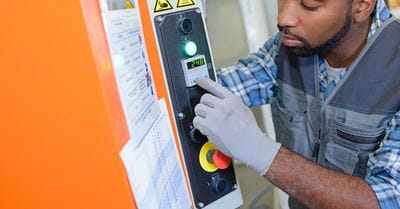Vertical Reciprocating Conveyors | Santa Barbara

Raymond West supplies warehouse automation equipment such as VRC's.
We are among the largest suppliers of warehouse automation equipment in the state.
Call us today at (805) 749-2777.
What Is a Vertical Reciprocating Conveyor (VRC)?
A vertical reciprocating conveyor is a safe, relatively inexpensive, simple means to move materials from one level to another. VRCs have applications in a host of different industries, including factories, storage facilities, distribution centers, and other multi-story facilities. These adaptable pieces of equipment may be readily integrated with a structure’s basement, mezzanine, balcony or any higher story levels.
VRC’s consist of a shaft, a carriage, and a mechanical or hydraulic system. Vertical material lifts can be added almost anywhere on the interior or exterior of a building. Barriers and cages installed around a VRC shaft keep workers safe and prevent accidents.
What Are Some Advantages of VRCs?
Safety: Many operations are dependent upon lift trucks for vertical movement of products. Although highly capable machines, forklifts are primarily intended for the horizontal transport of materials. In the name of efficiency, employees may sometimes stretch their forklifts beyond their height limit or move goods beyond their truck’s capacity rating. When such infractions happen, the chances of an accident increase substantially.
For some vertical product movement, VRCs provide a safe and efficient replacement for forklifts. Specifically designed and manufactured for each operation’s application demands, VRCs significantly diminish the possibility of human error.
In addition, VRCs are built to lift larger loads on a more frequent basis. These more rapid cycle rates mean less labor hours and lower costs. For companies that have routine vertical transport demands, VRCs can improve worker safety and lower labor expenses.
Customization: One major advantage of VRCs is the degree to which they can be adapted to unique requirements. Since passenger elevators are designed to safely move people, there are numerous regulations that limit the speed, capacity and size of these machines. Although such safety measures are necessary and advisable for safely moving humans, they are inhibitive for high volume movement of materials in factories, storage facilities and distribution operations. Vertical lifts can be freely customized because they are not bound by the same regulations as passenger elevators.
Regulation: Vertical reciprocating conveyors are engineered to move freight only, while elevators are meant to move both humans and cargo. Because of this fundamental difference, VRCs are exempt from the strict elevator rules in many states.
In lieu of local code, VRCs are regulated by their own universal code that is overseen by the American Society of Mechanical Engineers (ASME), one of the first standards establishing organizations in the United States. More specifically, vertical reciprocating conveyors must comply with ASME’s Safety Standard for Conveyor and Related Equipment (ASME B20.1-2018). This standard outlines the rules for the fabrication, assembly, operating procedure and servicing of conveyor systems.
Raymond West Is A Full Service Supplier of Vertical Reciprocating Conveyors
If you’re starting the procurement process for a VRC, have questions or need engineering assistance, Raymond West can help. Our conveyor system professionals can help design, procure, install and maintain a system that’s perfect for your operation. Give us a call today!
Raymond West's Santa Barbara County service area includes Buellton, Carpinteria, Goleta, Lompoc, Santa Barbara, Santa Maria and all surrounding areas.
Raymond West | Santa Barbara Material Handling Equipment Supplier
Santa Barbara County, CA
(805) 749-2777

